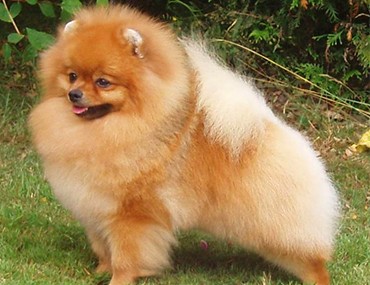Background
The tiny ball of fluff that we know as a Pomeranian used to be a lot bigger!
Originally used as sheep herders along the coast of the Baltic Sea in Pomerania – present day Germany and Poland – the Pomeranian has shrunk over the years.
The decrease in size came because of selective breeding, influenced mostly by the popularity of a single Pomeranian named “Windsor’s Marco” who was a tiny 12 pounds and happened to be the sidekick of Queen Victoria. When she displayed him in 1891, he immediately became a standard that all breeders strove to meet. The Pomeranian – known up until that time as the “Spitz dog,” was gradually bred smaller and smaller.
The first Pomeranian specialty show was held in the United States at the Waldorf Astoria Hotel in 1911. The breed continues to be popular today, ranking as the fifteenth most popular dog breed in America. 
Sizing Up
Pomeranians are tiny! Here are some common physical traits of the Pomeranian:
- Height: 7-12 in.
- Weight: 4-8 lbs.
- Lifespan: 12-15 years
- Color: Black with tan or mahogany details around the muzzle, legs, and tail
- Coat: long, thick double coat; constant shedder
What are they like?
We’ll put it this way: if a Pomeranian’s around, you’ll know about it.
A cocky, animated little dog disguised in a ball of thick fluff, the Pomeranian is very intelligent and loves to please. He’s a highly-trainable little bugger that loves to perform tricks and is often very curious about the world around him.
Because the Pomeranian is so small, he’s very portable and does great in apartment or condo settings. He is often able to get enough exercise in the living spaces through which he roams, so he won’t take a lot of your time up for exercise. A 15-20 minute walk will do the trick.
With the right training, the Pomeranian can be a good family dog (though it is best if they are around older children). He’s a great watchdog and can be a fearless little guardian of the home. Also, even with all that thick fur, the Pomeranian is pretty easy to groom because he’s so small. Brushing a few times per week should keep a Pomeranian comfortable and happy.
Generally a pretty healthy breed, the Pomeranian is prone to a few genetic medical conditions:
- Deafness
- Luxating patella, in which the kneecap pops out of place
- Cryptorchidism, retained testicles in puppies
- Patent ductus arteriousus (PDA), a congenital heart disorder
- Tracheal collapse
- Eye problems, such as progressive retinal atrophy (PRA)
Right for you?
Endlessly entertaining, the Pomeranian can be a lot of fun to have around. However, as with all pets, there are some things to think about before welcoming a Pomeranian into your family:
- The Pomeranian is a yapper. He’s pretty much vocal about everything, and he loves to tell you what’s on his mind. It takes some training to minimize his chattiness.
- Little Napoleons! Because of their short stature, the Pomeranian sometimes tries to take charge of his people and can also be over-protective of their owners and standoffish in new situations with new people. The Pomeranian needs a pack leader that is dominant and firm.
- While they are intelligent and easily pick up new tricks, the Pomeranian can be stubborn when it comes to housetraining. Part of this is because they are finicky about bad weather. You’ll have to patient.
- Pomeranians are not great for children. Because of their tiny size, the Pomeranian can be hurt by children who don’t know how to be gentle.
Trained and socialized the right way, a Pomeranian can be a great addition to many households.
If you have any questions or concerns, you should always visit or call your veterinarian – they are your best resource to ensure the health and well-being of your pets.
